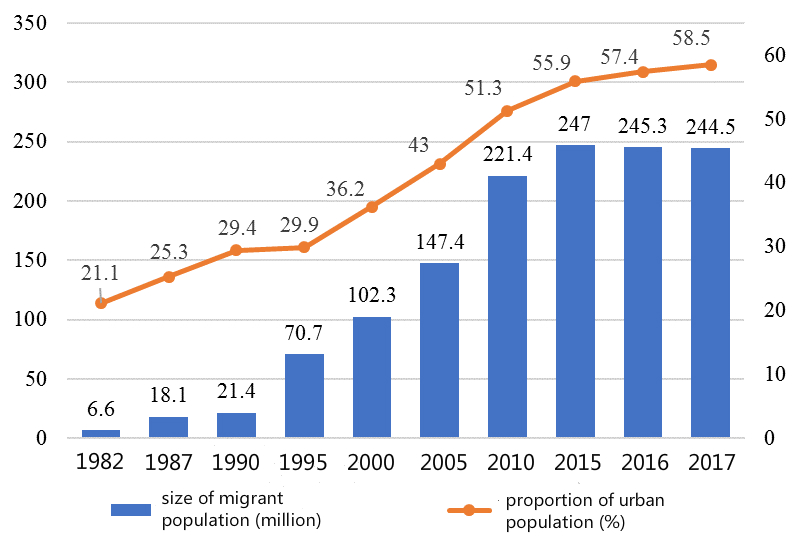China’s migrant population continues to decline, report says

The size of the migrant population and the proportion of urban residents between 1982 and 2017 Source: National Bureau of Statistics.
The number of migrants in China has fallen for three consecutive years to 244 million in 2017, according to the recent “China Migration Report 2018” from the National Health Commission.
The report reviews the three stages of China’s policies on its migrant population since the reform and opening up 41 years ago. At first, the country untethered restrictions on human migration, but only the central government took active action while local governments held back from supporting residents moving. Since the 21st century, a series of national documents have been released to promote the equal rights of the migrant population. During this period, governments at all levels implemented these policies vigorously. In the recent decade, the entire country has worked hard to help migrants adapt to urban life. The idea that the migrant population should benefit from reform and development has been well received.
The size of the migrant population reached a turning point in 2015. The ever-expanding group began a slow decline. Compared with 2014, the number of migrants across China dropped by 6 million, ending at 247 million in 2015. The figure decreased by another 1.7 million in 2016, and it continued to fall by 820,000 in 2017, according to the National Bureau of Statistics.
Scholars agree that human migration has stimulated the demographic dividend. From a micro perspective, the mass flow of rural surplus laborers into cities has enhanced the migrants’ ability to support their families. Meanwhile, the movement has aided social wealth accumulation in a macro sense.
The report emphasized that in recent years, China’s labor force, especially migrant workers, tended to return from the eastern coastal areas to the central and western regions. The labor-intensive industries and resource-intensive industries have started moving to the central and western regions. The process of laborers’ following industries will again reshape and perfect the allocation of human capital among regions.
Main sources of migrant populations include major labor suppliers, such as Henan Province, Anhui Province and Sichuan Province. People from these provinces constitute the majority of the migrants in coastal city clusters. In addition, adjacent provinces also have contributed to migrant populations, such as Hunan Province, the Pearl River Delta and the Yangtze River Delta.
More migrants tend to become permanent residents in their newly settled area. In the future, five regions will remain the major destinations of Chinese migrants, namely the Pearl River Delta, the Yangtze River Delta, the Beijing-Tianjin-Hebei Metropolitan Region, the middle reaches of the Yangtze River and the Chengdu-Chongqing area.
In addition, the report pays enormous attention to the elderly and left-behind children. The aging population keeps expanding while the size of migrant children has seen a minor decline over the past few years. Away from their parents, more than 90 percent of left-behind children are raised by their grandparents.
The then Population and Family Planning Commission, whose demographic work handed to the current National Health Comission, started to conduct this dynamic research on domestic migration in 2010. Since then, they have issued this annual report on the migrant population for nine consecutive years.
This article was translated from Xinhua.
(edited by YU HONG)
